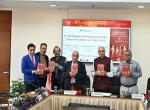On 8 October, VIF organized a lecture in the ‘Understanding Indian History & Civilization’ series. Kalamandalam Shri Piyal Bhattacharya, artist, researcher and founder of Chidakash Kalalay in Kolkata, spoke on ‘India’s Musical Footprints in Asia’.
The speaker pointed out that Indian musical instruments can be broadly divided into two categories—pre-10th century AD and post-10th century AD. What has come down to us today is essentially Indo-Persian music and belongs to the latter chronological category. Indian music before the 10th century was of a kind which we may today even find difficult to understand because we are no longer familiar with the nuances of that tradition. The harp, the tube zither and the stick zither belong to the pre-10th century musical tradition in India. The original forms of these instruments have virtually disappeared from mainstream India. But these instruments can be found more or less in their original form outside India in South East Asia. The talk thus traced the journey of some of these instruments from ancient India to Myanmar, Cambodia and other Southeast Asian countries.

The talk mainly focused on the string instruments as found in the classical treatise Natyasastra of Bharata Muni. Shri Bhattacharya discussed the different kinds of vina described in the Natyasastra—the ghosha vina (one-string tube zither), the chitra vina (seven-string arched harp), the vipanchi vina (nine-string arched harp), the mattakokila vina (21-string arched harp), and the kachchhapi vina (ancient lute with five strings). He then showed various sculptural relics that provide us a clue as to the original form of these vinas, as these instruments no longer exist in this form in the classical music repertoire of India at present. But, in India, these instruments exist in almost their original form among the tribal communities. For example, the tuhila, played by the Oraon tribe of Jharkhand, is exactly what the alapani vina of yore was. On the other hand, there exists in Cambodia a one-string stick zither, called the Kse Diev, which is almost identical with this kind of instrument. Thus, this form of vina can be seen in the sculptural relics of India of the 5th to 10th century AD, it can be found today among the Oraons of Jharkhand, and it is played today in Cambodia. The speaker thus charted the journey of this instrument in great detail. He then discussed the similar journey of various other string instruments, like the arched harp, which is believed to have travelled from India to Burma (Myanmar) after the 8th century AD. He then showed various kinds of evidence to explain this history of the circulation of Indian harps in other Asian countries. Once again, the typical Indian harp survives in India among the tribal communities, for example, the bin-baja of the Gond community.
Packed with scintillating imageries from sculptures and illustrations, videos of the actual sound of the instruments, and in-depth musicological discussion, the talk connected the intricate details of the history to music to the overall history of India and the entire South Asian and South East Asian region. It was an eye-opener as to the extent and reach of India’s cultural influence in the neighbourhood in ancient times.







Post new comment